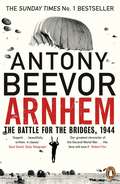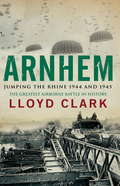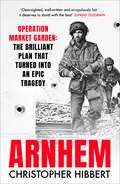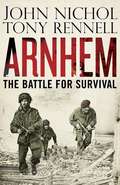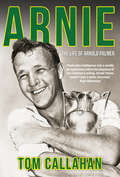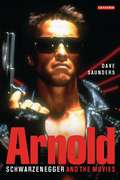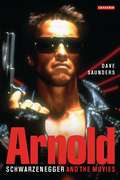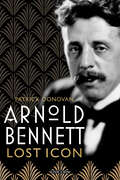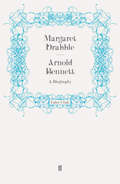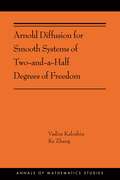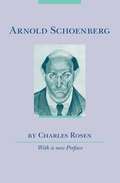- Table View
- List View
Arnheim for Film and Media Studies (AFI Film Readers)
by Scott HigginsRudolf Arnheim (1904-2007) was a pioneering figure in film studies, best known for his landmark book on silent cinema Film as Art. He ultimately became more famous as a scholar in the fields of art and art history, largely abandoning his theoretical work on cinema. However, his later aesthetic theories on form, perception and emotion should play an important role in contemporary film and media studies. In this enlightening new volume in the AFI Film Readers series, an international group of leading scholars revisits Arnheim’s legacy for film and media studies. In fourteen essays, the contributors bring Arnheim’s later work on the visual arts to bear on film and media, while also reassessing the implications of his film theory to help refine our grasp of Film as Art and related texts. The contributors discuss a broad range topics including Arnheim’s film writings in relation to modernism, his antipathy to sound as well as color in film, the formation of his early ideas on film against the social and political backdrop of the day, the wider uses of his methodology, and the implications of his work for digital media. This is essential reading for any film and media student or scholar seeking to understand the meaning and contemporary impact of Arnheim’s foundational work in film theory and aesthetics.
Arnheim, Gestalt and Art: A Psychological Theory
by Ian VerstegenArnheim, Gestalt and Art is the first book-length discussion of the powerful thinking of the psychologist of art, Rudolf Arnheim. Written as a complete overview of Arnheim’s thinking, it covers fundamental issues of the importance of psychological discussion of the arts, the status of gestalt psychology, the various sense modalities and media, and developmental issues. By proceeding in a direction from general to specific and then proceeding through dynamic processes as they unfold in time (creativity, development, etc.), the book discovers an unappreciated unity to Arnheim’s thinking. Not content to simply summarize Arnheim’s theory, however, Arnheim, Art, and Gestalt goes on to enrich (and occasionally question) Arnheim’s findings with the contemporary results of gestalt-theoretical research from around the world, but especially in Italy and Germany. The result is a workable overview of the psychology of art with bridges built to contemporary research, making Arnheim’s approach living and sustainable.
Arnheim, Gestalt and Media: An Ontological Theory (SpringerBriefs in Philosophy)
by Ian VerstegenThis monograph presents a synthesis and reconstruction of Rudolf Arnheim’s theory of media. Combining both Arnheim’s well-known writings on film and radio with his later work on the psychology of art, the author presents a coherent approach to the problem of the nature of a medium, space and time, and the differentia between different media. The latent ontological commitments of Arnheim’s theories is drawn out by affirming Arnheim’s membership in the Brentano school of Austrian philosophy, which allows his theories to be clarified and strengthened, particularly with the metaphysical writings of Roman Ingarden. The resulting theory is relational, portraying essential medial differences with neutral criteria and allowing for a rigorous definition of a medium. The way in which a medium is based on the inherent dispositions of medial materials creates a highly appealing theory that is determinate without being deterministic. The theory is thus highly timely as people in media studies seek to address the determinate nature of media after the post-medium condition. The book will appeal to researchers and graduate students in cultural and media studies as well as architecture and design.
Arnhem: The Battle for the Bridges, 1944: The Sunday Times No 1 Bestseller
by Antony BeevorThe Sunday Times #1 BestsellerThe great airborne battle for the bridges in 1944 by Britain's Number One bestselling historian and author of the classic Stalingrad'Our greatest chronicler of the Second World War . . . his fans will love it' - Robert Fox, Evening Standard'The eye for telling detail which we have come to expect from Antony Beevor. . . this time, though, he turns his brilliance as a military historian to a subject not just of defeat, but dunderhead stupidity' Daily Mail On 17 September 1944, General Kurt Student, the founder of Nazi Germany's parachute forces, heard the growing roar of aeroplane engines. He went out on to his balcony above the flat landscape of southern Holland to watch the air armada of Dakotas and gliders carrying the British 1st Airborne and the American 101st and 82nd Airborne divisions. He gazed up in envy at this massive demonstration of paratroop power. Operation Market Garden, the plan to end the war by capturing the bridges leading to the Lower Rhine and beyond, was a bold concept: the Americans thought it unusually bold for Field Marshal Montgomery. But could it ever have worked? The cost of failure was horrendous, above all for the Dutch, who risked everything to help. German reprisals were pitiless and cruel, and lasted until the end of the war. The British fascination with heroic failure has clouded the story of Arnhem in myths. Antony Beevor, using often overlooked sources from Dutch, British, American, Polish and German archives, has reconstructed the terrible reality of the fighting, which General Student himself called 'The Last German Victory'. Yet this book, written in Beevor's inimitable and gripping narrative style, is about much more than a single, dramatic battle. It looks into the very heart of war.'In Beevor's hands, Arnhem becomes a study of national character' - Ben Macintyre, The Times'Superb book, tirelessly researched and beautifully written' - Saul David, Daily Telegraph'Complete mastery of both the story and the sources' - Keith Lowe, Literary Review'Another masterwork from the most feted military historian of our time' - Jay Elwes, Prospect Magazine'The analysis he has produced of the disaster is forensic' - Giles Milton, Sunday Times'He is a master of his craft . . . we have here a definitive account' - Piers Paul Read, The Tablet
Arnhem: Nine Days of Battle
by Dr Chris BrownThe greatest airborne operation in history commenced on 17 September 1944. Nine days later nearly four out five of the British 1st Airborne Division and their Polish comrades would be killed, wounded or captured as Germany secured her last great battlefield victory of the war. The ferocious and gallant actions in Arnhem and Oosterbeek have fascinated historians and students ever since. Drawing extensively on eye-witness experience and unit diaries, and providing a detailed tactical and technical analysis of the arms, equipment and practices of the day, Arnhem: Nine Days of Battle provides a fascinating day-on-day account of one of the most iconic actions of the Second World War. Supported by battle maps, timelines, troop diagrams as well as touring guides – this is the perfect companion for the armchair historian or the intrepid battlefield traveller.
Arnhem: Jumping The Rhine 1944 And 1945
by Lloyd ClarkAn insightful and gripping account of the largest airborne operation in history. In September 1944, the river Rhine was a serious barrier to the advancing Allied armies in the West who were intent on charging Berlin and ending the war. Field Marshal Bernard Montgomery decided to utilise the First Allied Airborne Army consisting of British, American and Polish troops. Codenamed Operation Market Garden, 40,000 paratroopers were dropped behind enemy lines while ground forces linked to relieve them. But, due to bad weather and German resistance, the operation failed. In March 1945, asecond attempt was planned: Operation Varsity Plunder. This time the plan worked. Despite extremely heavy fighting, they cracked the German line.
Arnhem (GREAT BATTLES)
by Christopher HibbertThe vivid account of how a brilliant plan turned into an epic tragedy - made into the BAFTA award-winning film A BRIDGE TOO FAR'Alive with the detail that evokes the smoking background' DAILY TELEGRAPH'Finely recorded...truly the battle of Arnhem has been fortunate in its historian' SUNDAY TIMESThis book tells the true story of the Battle of Arnhem which was fought in September 1944. Nine thousand men of the First British Airborne Division were parachuted into the peaceful countryside that surrounded Arnhem. Their objective was to capture and hold the bridge over the Rhine ahead of the advancing British Second Army. Nine days later, after some of the fiercest street-fighting of the war, 2000 paratroopers managed to escape to safety.Made famous by the film A BRIDGE TOO FAR
Arnhem: The Classic Battle Told As Never Before
by Al Murray‘Utterly brilliant... this book really is the last word on the Battle of Arnhem’ James Holland’Superb... A military historian of originality and insight to compare with the best’ Saul David'This book is a revelation, not in facts delivered, but in the mood evoked. This is Arnhem unplugged By confining himself to men in and around Arnhem on that Tuesday, Murray achieves something special' The Times___________Al Murray has always been obsessed by this legendary battle, and in Arnhem: Black Tuesday he showcases all of his knowledge, interpretation and enthusiasm to bear to tell the story of one of history’s great heroic failures differently for the first time.The Battle of Arnhem is one of the best-known stories in British military history: a daring but doomed attempt to secure a vital bridgehead across the Rhine in order to end the war before Christmas 1944. It is always written about, with the benefit of unerring 20/20 hindsight, as being destined to fail, but the men who fought there, men of military legend, didn't know that that was to be their fate.By focusing on the events of one day as they happened through the eyes of the British participants and without bringing any knowledge of what would happen tomorrow to bear, Al Murray offers a very different perspective on a familiar narrative. Some things went right and a great many more went wrong, but recounting them in this way allows the reader to understand for the first time how certain decisions were taken in the moment and how opportunities were squandered.Tuesday 19 September 1944 was the terrible day which became known as Black Tuesday. From just after 12:00 hours while plans were being made to seize the initiative and optimism reigned, to the following midnight, when Arnhem was burning and the Allied fortunes looked very different, a mere twenty-four hours changed the course of the war.
Arnhem: The Battle for Survival
by John Nichol Tony RennellIn September 1944, a mighty shock force of battle hardened Allied troops dropped from the skies into enemy-occupied Holland in what was hoped would be the decisive final battle of World War II.Landing miles behind the German lines, their daring mission was to secure bridges across the Rhine so that ground forces could make a rapid dash into Nazi Germany. If all went well, the war could be over by Christmas.But what many trusted would be a simple operation turned into a brutal losing battle. Of 12,000 British airborne soldiers, 1,500 died and 6,000 were taken prisoner. The vital bridge at Arnhem they had come to capture stayed resolutely in German hands.But though this was a bitter military defeat for the Allies, beneath the humiliation was another story - of heroism and self-sacrifice, gallantry and survival, guts and determination unbroken in the face of impossible odds.In the two-thirds of a century that have passed since then, historians have endlessly analysed what went wrong and squabbled over who was to blame. Lost in the process was that other Arnhem story - the triumph of the human spirit, as seen through the dramatic first-hand accounts of those who were there, in the cauldron, fighting for their lives, fighting for their comrades, fighting for their honour, a battle they won hands down.
Arnhem: Fight Your Own Battle (EDGE: Battle Books #5)
by Gary SmailesTake up your weapons and prepare to fight your own battle in these all-action, interactive adventures, in which you take part in epic battles from throughout history.It is 1944 and Europe is still in the iron claw of Nazi German forces. In an attempt to end the war, British leaders have a plan to send elite troops deep behind German defences to capture key targets, including bridges. You are a Lieutenant in the 2nd Parachute Battalion. You must command your men forward through enemy territory and reach the bridge in the Dutch town of Arnhem. You must hold the bridge at any cost...
Arnhem Lift: A German Jew in the Glider Pilot Regiment
by Louis HagenOf the 10,000 men who landed at Arnhem, over nine days 1,400 were killed and more than 6,000 – about a third of them wounded – were captured. It wasa bloody disaster. The remarkable Louis Hagen, an ‘enemy alien’ who had escaped to England having been imprisoned and tortured in a Nazi concentration camp as a boy just a few years earlier, was one of the minority who made it back. What makes this book so unforgettable is not only the breathtaking drama of the story itself, it is the unmistakable talent of the writer. ‘Our huts had been locked and left just as they were when we left them on Monday morning. We took the keys, went in and sat down on our beds. The four of us looked round the hut. There were eighteen empty beds. It was very quiet now...The narrative was first published anonymously in 1945. 45 years later at a dinner party in Germany, Louis Hagen met Major Winrich Behr, Adjutant to Field Marshal Model at Arnhem. Louis added his side of the story to add even more insight to the original work.
Arnica the Duck Princess
by Ervin LázárA hilarious Hungarian classic children’s story, about true love, friendship and what happens when a witch turns your fiancé into a duck Princess Arnica is so sweet and gentle that when she smiles even wolves and bears forget their fierceness. Everyone loves her, but she loves only Poor Johnny. Luckily, he loves her too, and even more luckily Arnica has a very sensible king for a father, who is happy for her to marry whomever her heart desires. So, no problem then?Well, maybe just one – The Witch with a Hundred Faces has cast a spell on Arnica and Johnny which means that one of them must always be a duck, and the other human! Only the Seven-Headed Fairy can help them, but will they be able to find her in time?This is a hilarious classic children's tale about true love, friendship and, of course, what happens when your fiancé is turned into a duck. Ervin Lázár (1936–2006) was an award-winning and much-loved Hungarian children's author.He won many prizes, including the IBBY Book of the Year on three occasions, and was a runner-up for the 1982 Hans Christian Andersen Award. His stories for children have been translated into many languages, but Arnica the Duck Princess is the first to appear in English.
Arnie: The Life of Arnold Palmer
by Tom CallahanIn this definitive biography, veteran sportswriter Tom Callahan shines a spotlight on one of the greatest golfers ever to play the game: Arnold Palmer. The winner of more than ninety championships, including four Masters Tournaments, Arnold Palmer was a legend of twentieth-century sport: a supremely gifted competitor beloved for his powerful hitting, his nerve on the greens, and his great rapport with fans. Perhaps above all else, Palmer was the reason golf's popularity exploded, as the king of the links helped define golf's golden age along with Jack Nicklaus and Gary Player. In addition to his talent on the golf course, Palmer was a brilliant entrepreneur off it, and one of the first sportsmen to create his own successful marketing brand. Forging an alliance with sports agent Mark McCormack, Palmer converted his popularity into lucrative deals, and helped pave the way for the multi-million-dollar contracts that have become standard for stars across all sports. But beyond his business acumen, Palmer was always a larger-than-life character; filled with great stories from the key people in Palmer's life, Arnie is an entertaining and illuminating portrait of a remarkable man and his extraordinary legacy.
Arnold: Schwarzenegger and the Movies
by Dave Saunders"Arnold: Schwarzenegger and the Movies" is the first comprehensive, in-depth book to examine one of modern cinema's most celebrated and divisive screen presences. Tracing Schwarzenegger's entire film career and life from teenage bodybuilder to Governor of California, Saunders blends close textual readings of the major films, including "Pumping Iron", "Conan the Barbarian", The "Terminator" series, "Twins" and "True Lies", with salient historical context and biographical detail, demonstrating continually the importance of broader social and political factors in defining Arnold's unique significance. Representing far more than just a muscular spectacle, Saunders argues, Schwarzenegger found powerful ideological and spiritual relevance to his age by embarking on a quest to restore collective faith in his adopted nation - and, moreover, by exploiting his own, mythic importance to a post-war America struggling to come to terms with its own contemporary narrative.
Arnold: Schwarzenegger and the Movies
by Dave SaundersArnold: Schwarzenegger and the Movies' is the first comprehensive, in-depth book to examine one of modern cinema's most celebrated and divisive screen presences. Tracing Schwarzenegger's entire film career and life from teenage bodybuilder to Governor of California, Saunders blends close textual readings of the major films, including 'Pumping Iron', 'Conan the Barbarian', The 'Terminator' series, 'Twins' and 'True Lies', with salient historical context and biographical detail, demonstrating continually the importance of broader social and political factors in defining Arnold's unique significance. Representing far more than just a muscular spectacle, Saunders argues, Schwarzenegger found powerful ideological and spiritual relevance to his age by embarking on a quest to restore collective faith in his adopted nation - and, moreover, by exploiting his own, mythic importance to a post-war America struggling to come to terms with its own contemporary narrative.
Arnold and Boggs's Interpersonal Relationships - E-Book: Arnold and Boggs's Interpersonal Relationships - E-Book
by Claire Mallette Olive Yonge Elizabeth C. Arnold Kathleen Underman BoggsNow more than ever, effective communication skills are key for successful patient care and positive outcomes. Arnold and Boggs’s Interpersonal Relationships: Professional Communication Skills for Canadian Nurses helps you develop essential skills for communicating effectively with patients, families, and colleagues in order to achieve treatment goals in health care. Using clear, practical guidelines, it shows how to enhance the nurse-patient relationship through proven communication strategies, as well as principles drawn from nursing, psychology, and related theoretical frameworks. With a uniquely Canadian approach, and a variety of case studies, interactive exercises, and evidence-informed practice studies, this text ensures you learn how to apply theory to real-life practice.
Arnold Bake: A Life with South Asian Music (SOAS Studies in Music)
by Bob Van Der LindenArnold Bake (1899–1963) was a Dutch pioneer in South Asian ethnomusicology, whose research impressed not only the most renowned Indologists of his time but also the leading figures in the emerging field of ethnomusicology. This long overdue biography sheds light on his knowledge of the theory and practice of South Asian music, as well as his legacy on the intellectual history of ethnomusicology. Bake spent nearly seventeen years in the Indian subcontinent and made numerous, irreplaceable recordings, films and photographs of local musicians and dancers. As a gifted Western musician, he studied Indian singing with Bhimrao Shastri, Dinendranath Tagore and Nabadwip Brajabashi, and successfully performed Rabindranath Tagore’s compositions and South Asian folk songs during hundreds of lecture-recitals in India, Europe and the United States. For the last fifteen years of his life, Bake taught Indian music at the School of Oriental and African Studies (SOAS), University of London; he was the first to do so at a Western university. Besides his numerous writings and radio presentations, he advanced his subject through his activities in British and international research associations. The history of ethnomusicology, especially as applied to South Asia, cannot be fully understood without regard to Bake, and yet his contribution has remained, until now, unclear and unknown.
Arnold Bake: A Life with South Asian Music (SOAS Studies in Music)
by Bob Van Der LindenArnold Bake (1899–1963) was a Dutch pioneer in South Asian ethnomusicology, whose research impressed not only the most renowned Indologists of his time but also the leading figures in the emerging field of ethnomusicology. This long overdue biography sheds light on his knowledge of the theory and practice of South Asian music, as well as his legacy on the intellectual history of ethnomusicology. Bake spent nearly seventeen years in the Indian subcontinent and made numerous, irreplaceable recordings, films and photographs of local musicians and dancers. As a gifted Western musician, he studied Indian singing with Bhimrao Shastri, Dinendranath Tagore and Nabadwip Brajabashi, and successfully performed Rabindranath Tagore’s compositions and South Asian folk songs during hundreds of lecture-recitals in India, Europe and the United States. For the last fifteen years of his life, Bake taught Indian music at the School of Oriental and African Studies (SOAS), University of London; he was the first to do so at a Western university. Besides his numerous writings and radio presentations, he advanced his subject through his activities in British and international research associations. The history of ethnomusicology, especially as applied to South Asia, cannot be fully understood without regard to Bake, and yet his contribution has remained, until now, unclear and unknown.
Arnold Bennett: Lost Icon
by Patrick DonovanDuring his 1920s heyday, Arnold Bennett was one of Britain’s most celebrated writers. As the author of The Old Wives’ Tale and Clayhanger he was a household name, writing just as much for the common man as London’s literati. His face was plastered over theatre hoardings and the sides of West End omnibuses. His life represents the ultimate rags-to-riches story of a man who ‘banged on the door of Fortune like a weekly debt collector’ as one of his obituaries so vividly put it. Yet for all his success, few were aware how cursed Bennett felt by his life-long stutter and other debilitating character traits. In the years running up to his death in 1931, his affairs were close to collapse as he fought a losing battle on three fronts: with his estranged wife; with his disenchanted mistress; and from a literary perspective with Virginia Woolf. As the first full length biography of Bennett since 1974, the work draws on a wealth of unpublished diaries and letters to shed new light on a personality who can be considered a ‘Lost Icon’ of early Twentieth Century Britain.
Arnold Bennett: A Biography
by Margaret Drabble'Arnold Bennett was born in a street called Hope Street. A street less hopeful it would be hard to imagine.' Thus begins Margaret Drabble's biography of a man whose most famous achievement was to re-create, in such novels as The Old Wives' Tale and Clayhanger, the life, atmosphere and character of the 'Five Towns' region in which he was born and grew up.Arnold Bennett is a very personal book. 'What interests me', writes the author, 'is Bennett's background, his childhood and origins, for they are very similar to my own. My mother's family came from the Potteries, and the Bennett novels seem to me to portray a way of life that still existed when I was a child, and indeed persists in certain areas. So like all books this has been partly an act of self-exploration.'Of Bennett as a writer Drabble says 'The best books I think are very fine indeed, on the highest level, deeply moving, original and dealing with material that I had never before encountered in fiction, but only in life: I feel they have been underrated, and my response to them is so constant, even after years of work on them and constant re-readings, that I want to communicate enthusiasm.'Of Bennett as a man she paints an affectionate portrait, not glossing over the irritability, dyspepsia and rigidity which at times made him so difficult a companion but reminding us too of his honesty, kindliness and sensitivity. 'Many a time,' she writes at the end of the book, 're-reading a novel, reading a letter or a piece of his Journal, I have wanted to shake his hand, or to thank him, to say well done. I have written this instead.'
Arnold Bennett A Last Word: A Last Word
by Frank Swinnerton'I have tried to depict Arnold Bennett as a man of character and integrity, a fundamentally innocent humorist, a superlative friend, and, to others, not myself, a difficult personality; but I have worked under considerable difficulties, with many interruptions, and the result may be unsatisfactory. If it is, I shall be sorry. One of my problems has arisen from the fact that to live again, as I have done, in a period long past and full of painful memories, has proved agitating and therefore exhausting.'Arnold Bennett (1867-1931) was a prolific English writer and journalist. He was a friend and benefactor to many writers of his generation including H. G. Wells, John Galsworthy, Aldous Huxley, and Siegfried Sassoon. Frank Swinnerton became acquainted with Bennett after sending him a draft of his first novel and later they became close friends over the course of many years. He wrote this detailed biography of Bennett some years after his death. It was first published in 1978.
Arnold Diffusion for Smooth Systems of Two and a Half Degrees of Freedom: (AMS-208) (Annals of Mathematics Studies #391)
by Vadim Kaloshin Ke ZhangThe first complete proof of Arnold diffusion—one of the most important problems in dynamical systems and mathematical physicsArnold diffusion, which concerns the appearance of chaos in classical mechanics, is one of the most important problems in the fields of dynamical systems and mathematical physics. Since it was discovered by Vladimir Arnold in 1963, it has attracted the efforts of some of the most prominent researchers in mathematics. The question is whether a typical perturbation of a particular system will result in chaotic or unstable dynamical phenomena. In this groundbreaking book, Vadim Kaloshin and Ke Zhang provide the first complete proof of Arnold diffusion, demonstrating that that there is topological instability for typical perturbations of five-dimensional integrable systems (two and a half degrees of freedom).This proof realizes a plan John Mather announced in 2003 but was unable to complete before his death. Kaloshin and Zhang follow Mather's strategy but emphasize a more Hamiltonian approach, tying together normal forms theory, hyperbolic theory, Mather theory, and weak KAM theory. Offering a complete, clean, and modern explanation of the steps involved in the proof, and a clear account of background material, this book is designed to be accessible to students as well as researchers. The result is a critical contribution to mathematical physics and dynamical systems, especially Hamiltonian systems.
Arnold Drive: Can a man keep his faith when he's lost his way?
by Hugh CornwellNothing much has ever happened to Rev Arnold Drive, the meekly quiet vicar of St Tobias's. Feeling safe only within the walls of his church and the gentle rules of his faith, Arnold is ironically a man utterly without drive; a man content that nothing much ever happens. Nothing, that is, until the day his church is sold off to property developers. Ejected from his church and his home, Arnold is thrust out into the modern world – a world for which he is utterly ill-equipped. Suddenly, life presents Arnold with a series of moral dilemmas that test his faith, his judgement and his understanding of human nature. His first experience of love and sex, a surprise confession of murder, a suicide, the prospect of unexpected wealth, the discovery of a hidden family history, all cause Arnold to reassess the certainties he has taken for granted. Then, a near-fatal car accident forces him to face up to the fragility of sanity and of life itself... Arnold Drive is the story of a man's journey from innocence to experience where he discovers his moral compass isn't always pointing the right way.
The Arnold-Gelfand Mathematical Seminars
by V Arnold I. M. Gelfand Mikhail Smirnov Vladimir S RetakhArnold Schoenberg (Princeton Legacy Library)
by Charles RosenIn this lucid, revealing book, award-winning pianist and scholar Charles Rosen sheds light on the elusive music of Arnold Schoenberg and his challenge to conventional musical forms. Rosen argues that Schoenberg's music, with its atonality and dissonance, possesses a rare balance of form and emotion, making it, according to Rosen, "the most expressive music ever written." Concise and accessible, this book will appeal to fans, non-fans, and scholars of Schoenberg, and to those who have yet to be introduced to the works of one of the greatest composers of the twentieth century. "Arnold Schoenberg is one of the most brilliant monographs ever to be published on any composer, let alone the most difficult master of the present age. . . . Indispensable to anyone seeking to understand the crucial musical ideas of the first three decades."—Robert Craft, New York Review of Books "What Mr. Rosen does far better than one could reasonably expect in so concise a book is not only elucidate Schoenberg's composing techniques and artistic philosophy but to place them in history."—Donal Henahan, New York Times Book Review "For the novice and the knowledgeable, Mr. Rosen's book is very important reading, either as an introduction to the master or as a stimulus to rethinking our opinions of him. Mr. Rosen's accomplishment is enviable."—Joel Sachs, Musical Quarterly



